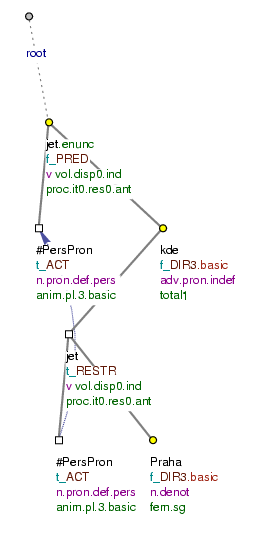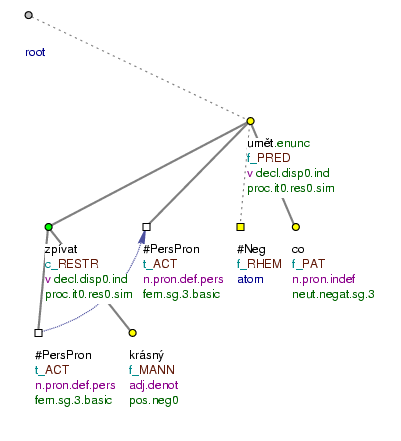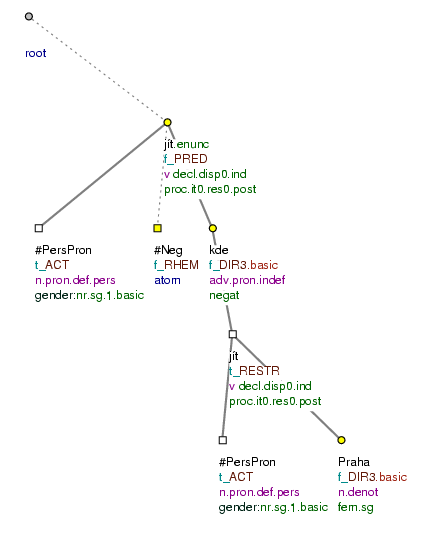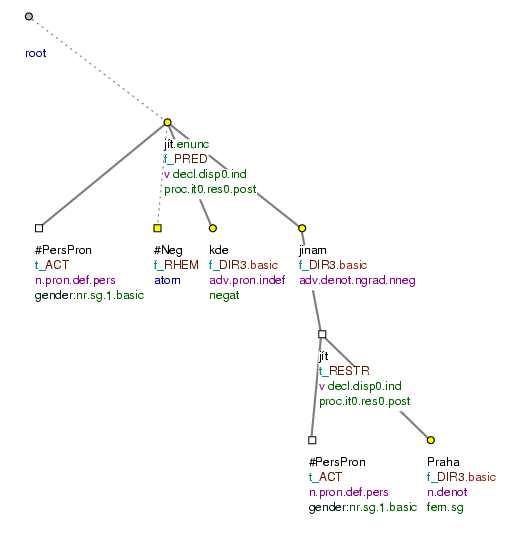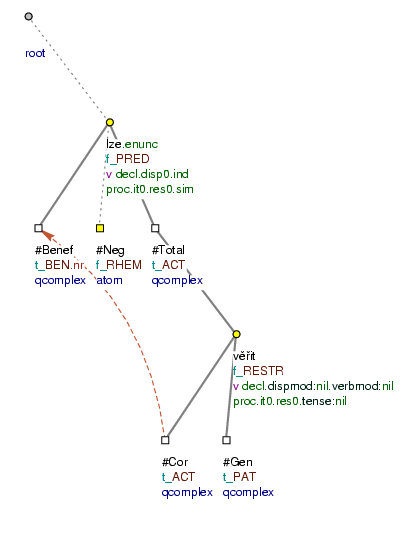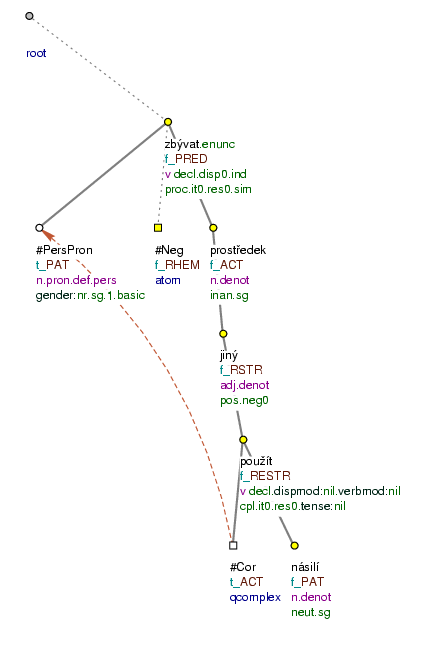Constructions signifying restriction (restrictive constructions) are constructions which restrict the validity of a totalising expression (každý (=each), celý (=whole), všechen (=all), nic (=nothing), nikam (=nowhere) etc.), or which introduce an exception to a state of conventionality, normality or regularity. For example:
Máme všechno až na to nejdůležitější. (=We have everything except what is most important.) Fig. 8.105
Nemám nikoho kromě tebe. (=I have nobody but you.)
Vyjma soboty všechno probíhalo normálně. (=With the exception of Saturday, everything went as normal.)
Proto budou rovněž i výsledky obchodování zveřejňovány denně, kromě pondělí a neděle. (=Therefore the trading results will likewise be published daily, except for Monday and Sunday.)
The effective root node of the restrictive construction is assigned the functor RESTR and in the tectogrammatical tree it is dependent on the node for the totaliser or other expression of total quantity, state of normality, regularity or conventionality.
Substitute totaliser. If the totalising expression is not explicit at surface level, a new node with the t-lemma substitute #Totalis added to the tectogrammatical tree. The node with the t-lemma substitute #Total
Additional examples:
Mimo tebe.RESTR nepřišel nikdo. (=Apart from you, nobody came.) Fig. 8.103
Mimo datum.RESTR se píší {#Total.RSTR} řadové číslice slovy. (=Except for dates, ordinal numerals are written in words.) Fig. 8.104
Figure 8.103. Construction signifying restriction
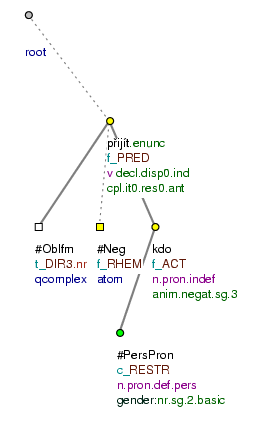
Mimo tebe nepřišel nikdo . (=lit. Apart_from you, not_came nobody.)
Figure 8.104. Construction signifying restriction
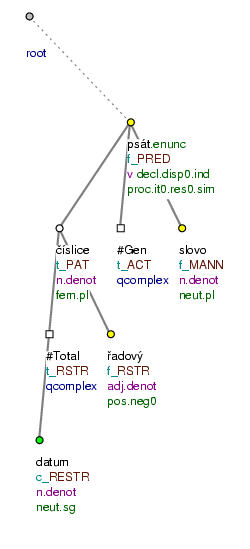
Mimo datum se píší řadové číslice slovy. (=lit. Except_for dates REFL write ordinal numerals in_words.)
Constructions signifying restriction are divided into three groups:
-
constructions signifying restriction attached by prepositions (see Section 6.1.1, "Constructions signifying "restriction" attached by prepositions"),
-
constructions signifying restriction attached by connectives (see Section 6.1.2, "Constructions signifying "restriction" attached by connectives"),
-
constructions signifying restriction of the type "nezbývá než doufat (=one can only hope)" (see Section 6.1.3, "Constructions signifying restriction of the type "nezbývá než doufat (=one can only hope)"").
!!! Rules for the representation of constructions signifying restriction and exceptional conjoining have been created gradually during the course of the annotation. It was not possible to revise all annotated trees according to the definitive rules before the issue of PDT 2.0. The assignment of the functor RESTR is reliable, but not the structure of the tectogrammatical tree. The effective root node of a construction signifying restriction is in most cases not dependent on the node for the totalising expression but directly on the governing verb of the main clause.
Constructions signifying restriction are commonly attached by the prepositions:
| kromě (=besides/except) |
| mimo (=except) |
| vedle (=apart from) |
| vyjma (=except) |
| až na (=except for) |
| s výjimkou (=with the exception) |
Restrictive constructions attached by prepositions are divided into:
-
direct restriction .
The effective root node of the restrictive construction is the node representing the governing (syntactic) noun of the prepositional group.
-
restriction with ellipsis of the verb.
The effective root node of the restrictive construction is not the node representing the governing (syntactic) noun of the prepositional phrase but the newly established node for the verb.
-
restriction attached by the expression "kromě/vedle/mimo toho, že". (=besides/apart from the fact that)
Direct restriction. The node representing the governing (syntactic) noun of the prepositional phrase is the effective root node of the restrictive construction in cases where this noun is in the case governed by the preposition. (A reference to the preposition is stored in the attribute a/aux.rf at the node of the governing noun.)
With the prepositions až na (=except for), s výjimkou (=with the exception) the node representing the governing noun of the prepositional phrase is always the effective root node of the restrictive construction. Nouns following these prepositions are always in the case governed by the prepositions. For example:
Máme všechno až na to.RESTR nejdůležitější. (=We have everything except what is most important.) Fig. 8.105
With the prepositions kromě (=besides/except), mimo (=except), vedle (=apart from), vyjma (=except) the effective root node of the restrictive construction is the node representing the governing noun of the prepositional phrase only when the noun is in the case governed by the preposition; thus: kromě+2, mimo+4 (in the texts substandardly also with genitive), vedle+2, vyjma+2. For example:
Kromě tohoto týdne.RESTR budu učit pravidelně. (=Except this week I will be teaching regularly.) Fig. 8.106
Kromě otevření.RESTR hranic nebyly vytvořeny žádné stimulující podmínky pro cestovní ruch. (=Apart from the opening of the border, no conditions were created to encourage tourism.) Fig. 8.107
Kromě Jihočeské keramiky.RESTR nepatří {#Total.RSTR} tyto firmy mezi nejsilnější. (=Except South Bohemian Ceramics, these companies are not amongst the strongest.) Fig. 8.108
Restriction with ellipsis of the verb. The newly established node for the verb is the effective root node of the restrictive construction in cases where the governing (syntactic) noun of the prepositional phrase is in a different case, not that governed by the preposition, or where the prepositions kromě (=besides, except), mimo (=except), vedle (=apart from) or vyjma (=excepting) are followed by a further prepositional phrase. (Reference to the preposition is stored in the attribute a/aux.rf at the added node for the verb.)
The newly added node is usually a copy of the node for the verb in the main clause (or a node with the t-lemma substitute #EmpVerb is added). The rule regarding negation of an added verb is: if the verb in the main clause is negated, the newly added verb is not negated, and vice versa. Cf.:
-
Kromě do Prahy chtěli jet všude. (=Except for Prague (lit. to Prague), they wanted to go everywhere.)
= Kromě toho, že nechtěli jet do Prahy, chtěli jet všude. (=Apart from the fact that they did not want to go to Prague, they wanted to go everywhere.)
The effective root node of the restrictive construction will be the newly established node for the verb which will be a copy of the node for the verb in the main clause. Under the newly established node for the verb is inserted a node for syntactic negation (
t_lemma=#Neg;functor=RHEM). Cf. Fig. 8.109.
The reason for the addition of a node for the verb is that the existing case form of the noun phrase is not determined by the preceding preposition; thus the case form of the noun phrase in the restrictive construction can only be explained if it is a modification of the elided verb, which also enables the noun phrase to be assigned a corresponding functor, which would otherwise be covered by the functor RESTR.
Cf:
-
kromě Pavla (=except Paul); kromě Prahy (=except Prague); kromě ledna (=except January); mimo tebe (=except you); vedle historie (=apart from history)
These prepositional phrases are represented by one node with the functor
RESTR(direct restriction). -
kromě mamince (=except to mum); kromě do Prahy (=except to Prague); mimo do Prahy (=except to Prague); vyjma od tebe (=except from you); vedle do Prahy (=apart from (going) to Prague)
These expressions are treated as constructions with ellipsis of the verb on which the noun phrase following the prepositions kromě (=except), mimo (=except), vedle (=apart from) or vyjma (=except) is dependent (restriction with ellipsis of the verb).
!!! Constructions in which the prepositions (kromě, mimo, vedle) would be followed by a form other than that governed by the preposition do not, however, occur in PDT.
Restriction attached by the expression "kromě/vedle/mimo toho, že (=except for/apart from the fact that)". In restrictive constructions attached by the expression "kromě/vedle/mimo toho, že (=besides/except for the fact that)" the expression "toho (=the fact)" is treated as a supporting expression (see Section 5.3, "Supporting expressions") and the functor RESTR is assigned to the effective root node of the dependent clause. For example:
<Kromě toho, že> krásně zpívá.RESTR , neumí nic. (=Apart from the fact that he/she sings beautifully, he/she is not capable of anything.) Fig. 8.110
NB! Not every construction containing a totalising expression signifies restriction. The construction may contain a totaliser which is not restricted. The construction then signifies exceptional conjoining. Cf.:
-
Kromě historie studovala všechno. (=Except history, she studied everything.)
= Studovala všechno, jenom nestudovala historii. (=She studied everything; she only omitted to study history.)
The construction signifies restriction.
-
Kromě historie studovala i všechno ostatní. (=Besides history, she also studied everything else.)
= Studovala historii i všechno ostatní. (=She studied history and also everything else.)
The construction signifies exceptional conjoining.
The clause may also be homonymous, as far as signifying restriction or exceptional conjoining is concerned. The homonymy of the construction is removed in annotation (on the basis of the context). Cf.:
-
Kromě ní přišla celá parta. (=Except her the whole crowd came.)
-
= Celá parta přišla, jen ona nepřišla. (=The whole crowd came; she was the only one who didn't come.)
The meaning of restriction.
-
= Přišla ona i celá parta. (=She came, and the whole crowd as well.)
The meaning of exceptional conjoining.
-
Figure 8.105. Construction signifying restriction
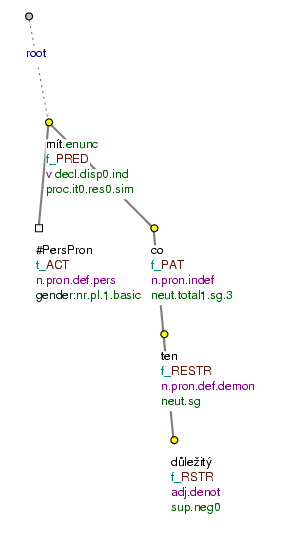
Máme všechno až na to nejdůležitější. (=lit. (We) have everything except for that most_important.)
Figure 8.106. Construction signifying restriction
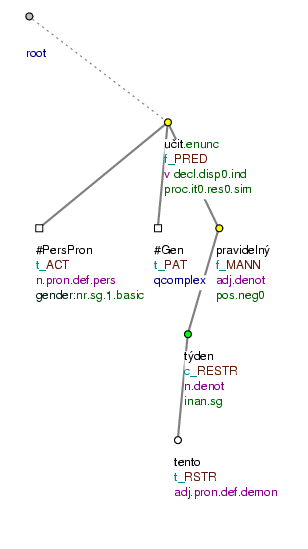
Kromě tohoto týdne budu učit pravidelně. (=lit. Except this week, (I) will be_teaching regularly.)
Figure 8.107. Construction signifying restriction
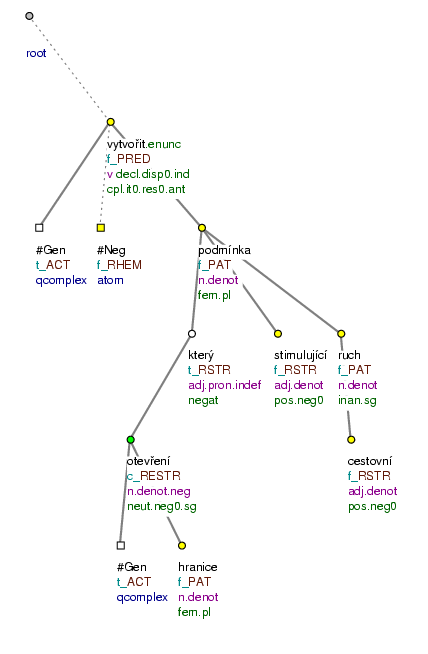
Kromě otevření hranic nebyly vytvořeny žádné stimulující podmínky pro cestovní ruch. (=lit. Apart_from (the) opening (of the) border, not_were created no stimulating conditions for - tourism.)
Figure 8.108. Construction signifying restriction
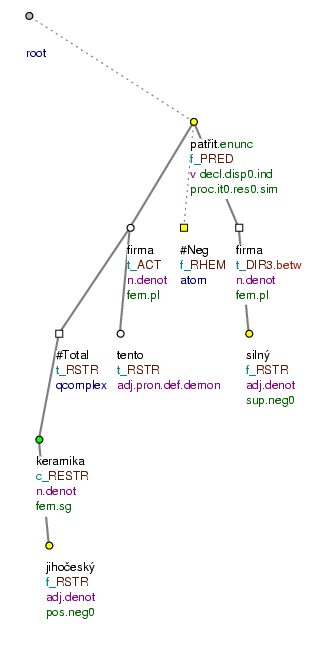
Kromě Jihočeské keramiky nepatří tyto firmy mezi nejsilnější. (=lit. Except South_Bohemian Ceramics do_not_belong these companies amongst the_strongest.)
Constructions signifying restriction are commonly attached by the connectives:
| než (=than) |
| nežli (=than) |
| leda (=unless) |
| ledaže (=unless) |
Constructions signifying restriction attached by connectives are always interpreted as dependent verbal clauses (see Section 4, "Verbal and non-verbal clauses").
Thus if no governing verb is present at surface level in the restrictive construction attached by a connective, a new node is added to the tectogrammatical tree in the place of this absent verb. The newly established node is usually a copy of the node for the verb in the main clause (sometimes a node is added with the t-lemma substitute #EmpVerb). The rule relating to the negation of an added verb is: if the main clause contains a negated verb, the newly established verb is not negated, and vice versa.
Examples:
To nikde na světě není než { být.RESTR} u nás doma. (=That does not exist anywhere in the world except in our country.) Fig. 8.111
Maminka nechodí {#Total.DIR3} než { chodit.RESTR} k sousedkám. (=Mum doesn't go anywhere except to the neighbours'.) Fig. 8.112
Není možné se soustředit na nic jiného než { soustředit_se.RESTR} na vše přehlušující hluk. (=It is impossible to concentrate on anything other than the deafening noise.) Fig. 8.113
Nepovím {#Total.EFF} , leda by na to přišli.RESTR sami. (=I won't say, unless they find out for themselves.) Fig. 8.114
Nikoho tam nepouštěj, leda by přišel.RESTR někdo z úřadu. (=Don't let anybody in, unless someone from the office comes.) Fig. 8.115
The reason for the addition of the verb is that the conjunction does not require a specific construction, thus the case form of the nouns in the restrictive construction can only be explained if there is a verb in the structure, although not present at surface level; this also enables the noun phrase to be assigned an appropriate functor, which would otherwise be covered by the functor RESTR.
The meaning of "restriction" vs. the meaning of "comparison". Constructions signifying restriction are formally (and frequently semantically) associated with other constructions attached by the same connectives. In particular, certain restrictive constructions attached by the conjuction než (=than) are similar to constructions signifying comparison (see Section 4, "Constructions with the meaning of "comparison""). Constructions with the expressions jinak než (=other than), jindy než (=at a time other than), jinde než (=elsewhere than), jiný než (=other than) etc. are constructions which (apart from set idiomatic phrases, see Section 6.1.3, "Constructions signifying restriction of the type "nezbývá než doufat (=one can only hope)"") are represented as constructions signifying comparison. Only constructions with true totalisers are represented as restrictive: nikde než (=nowhere but), nic než (=nothing but), nikam než (=nowhere but). Constructions in which both types of expression occur in pairs: nikam jinam (=(to) nowhere else), nikde jinde (=nowhere else), nic jiného (=nothing else) are represented as constructions signifying restriction. Cf.:
-
Nepůjdu nikam než do Prahy. (=I won't go anywhere but Prague.)
The restrictive meaning is represented in the construction. Cf. Fig. 8.116.
-
Nepůjdu nikam jinam než do Prahy. (=I won't go anywhere else but Prague.)
The restrictive meaning is represented in the construction. Cf. Fig. 8.117.
-
Nepůjdu jinam než do Prahy. (=I won't go anywhere else but Prague.)
The meaning of comparison is represented in the construction.
Figure 8.111. Construction signifying restriction
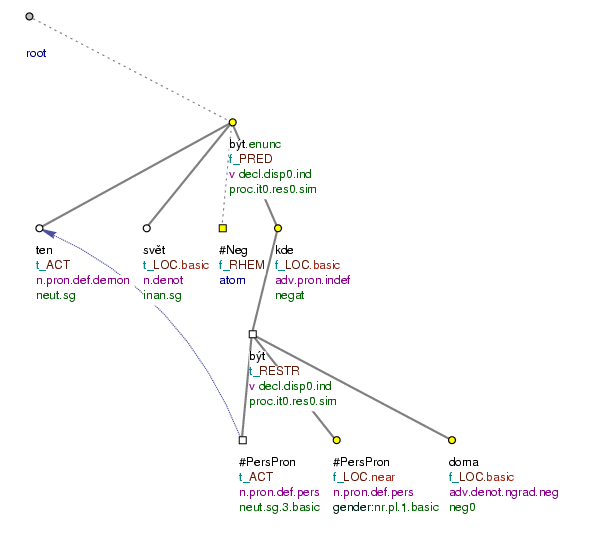
To nikde na světě není než u nás doma. (=lit. That nowhere in (the) world is_not except at us home.)
Figure 8.112. Construction signifying restriction
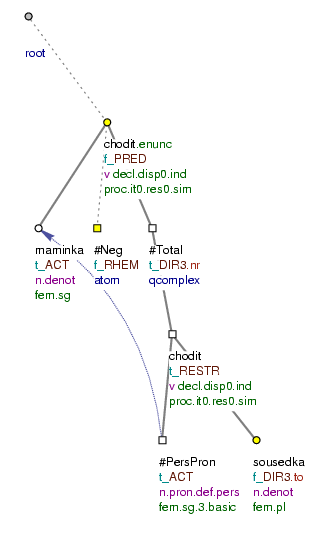
Maminka nechodí než k sousedkám. (=lit. Mum doesn't_go (anywhere) except to (the) neighbours'.)
Figure 8.113. Construction signifying restriction
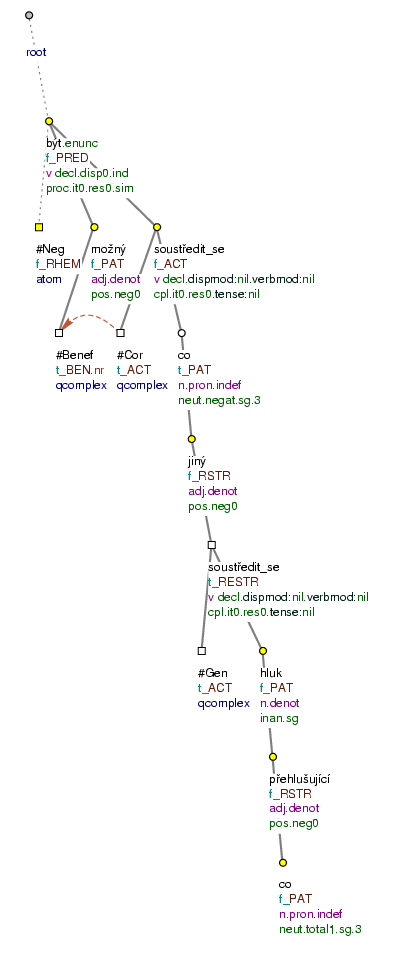
Není možné se soustředit na nic jiného než na vše přehlušující hluk. (=lit. (It) is_not possible REFL to_concentrate on nothing other than on (the) all covering noise.)
Figure 8.114. Construction signifying restriction

Nepovím, leda by na to přišli sami. (=lit. (I) won't_say, unless (they) would - that find_out for_themselves.)
Figure 8.115. Construction signifying restriction
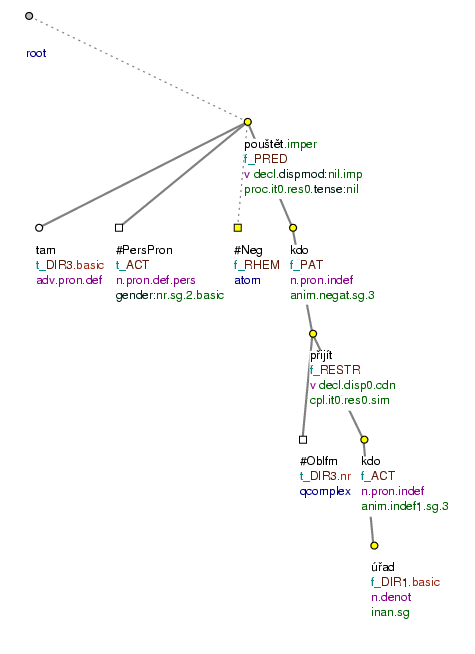
Nikoho tam nepouštěj, leda by přišel někdo z úřadu. (=lit. Nobody there let_in, unless would come someone from (the) office.)
The following set idiomatic phrases are also represented as constructions signifying restriction:
-
nezbývá než (=one can only) + infinitive,
-
nelze než (=one cannot but) + infinitive,
-
other similar constructions.
Examples:
Nezbývá mi nic než doufat.RESTR (=All I can do is hope.) Fig. 8.118
Nelze {#Total.ACT} než věřit.RESTR (=One can only have faith.) Fig. 8.119
Nezbývá mi jiný prostředek než použít.RESTR násilí. (=The only means left to me is the use of force.) Fig. 8.120
Nemohu nic než doufat.RESTR (=I can do no more than hope.)
Here, the functor RESTR has its own node representing the infinitive of the verb (no copy of the node for the verb in the main clause - zbývat (=to remain), lze (=is possible) etc. - is added to the tectogrammatical tree). The node for the expressed infinitive with the functor RESTR is dependent on the totaliser nic (=nothing) (or on a synonym, for example: jiná možnost (=another possibility), jiný prostředek (=other means), jiná věc (=another thing)). If the totaliser is not expressed at surface level, a new node with the t-lemma substitute #Total is added to the construction.
NB! Only semantically empty expressions are treated as synonymous with the totaliser nic (=nothing). Other constructions with the phrase jiný než (=other than) are represented as constructions signifying comparison (see Section 4, "Constructions with the meaning of "comparison""). Cf.:
-
Nezbývá mi jiný prostředek než použít násilí. (=The only means left to me is the use of force.)
= Nezbývá mi nic než použít násilí. (=All that is left to me is the use of force.)
Here, the phrase jiný prostředek (=other means) is synonymous with the totaliser nic (=nothing); therefore the meaning of restriction is represented in the construction. Cf. Fig. 8.120.
-
Používám jiný prostředek/prášek na praní než Palmex. (=I use a different washing powder, not Palmex.)
Here, the phrase jiný prostředek (=lit. another means) is not synonymous with the totaliser nic (=nothing); the meaning of comparison is represented in the construction.
NB! The phrase nic (=nothing) + comparative is represented as comparison. Cf.:
-
Nenapadá mě nic logičtějšího než podat demisi. (=I cannot think of anything more logical than to resign.)
The effective root node of the construction attached by the conjunction než (=than) has the functor
CPRand it is dependent on the node representing the comparative logičtější (=more logical).
Figure 8.118. Construction of the type "nezbývá než doufat"
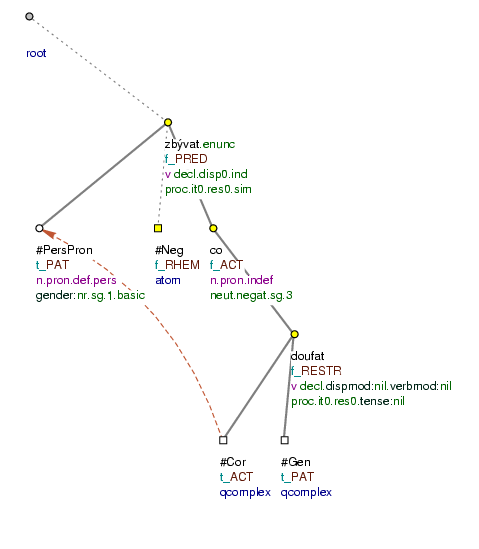
Nezbývá mi nic než doufat. (=lit. Not_is_left for_me nothing but to_hope.)
